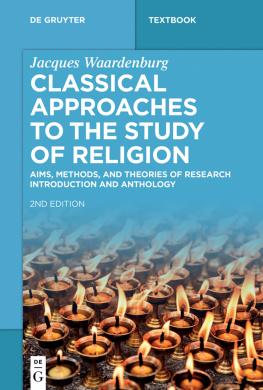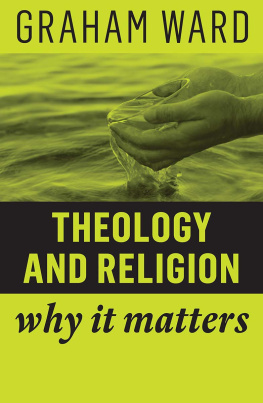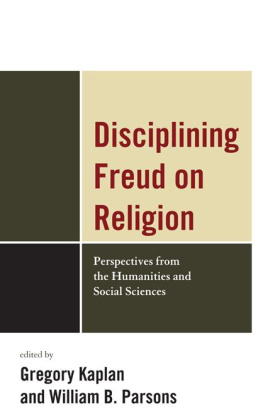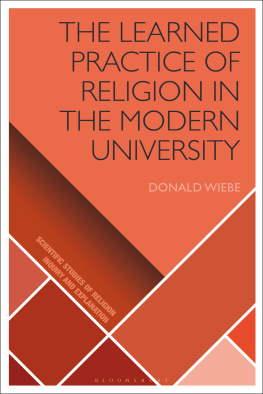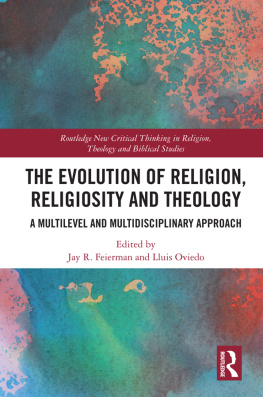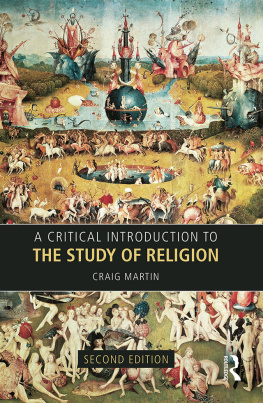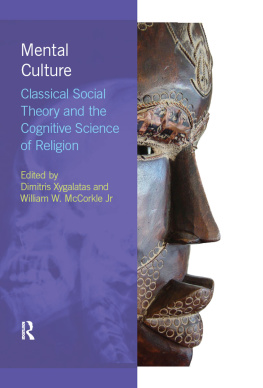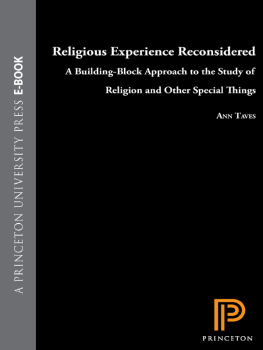Contents
Guide
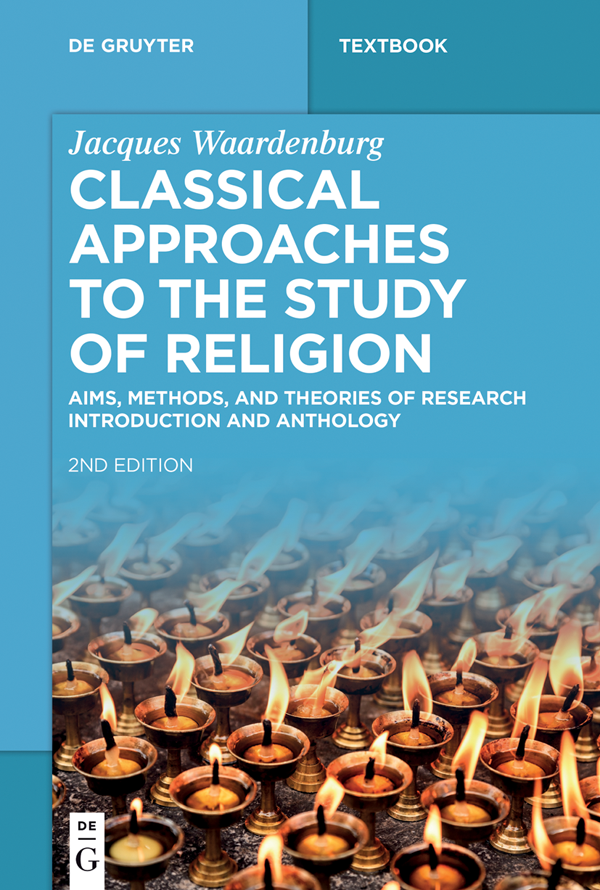
Jacques Waardenburg
Classical Approaches to the Study of Religion
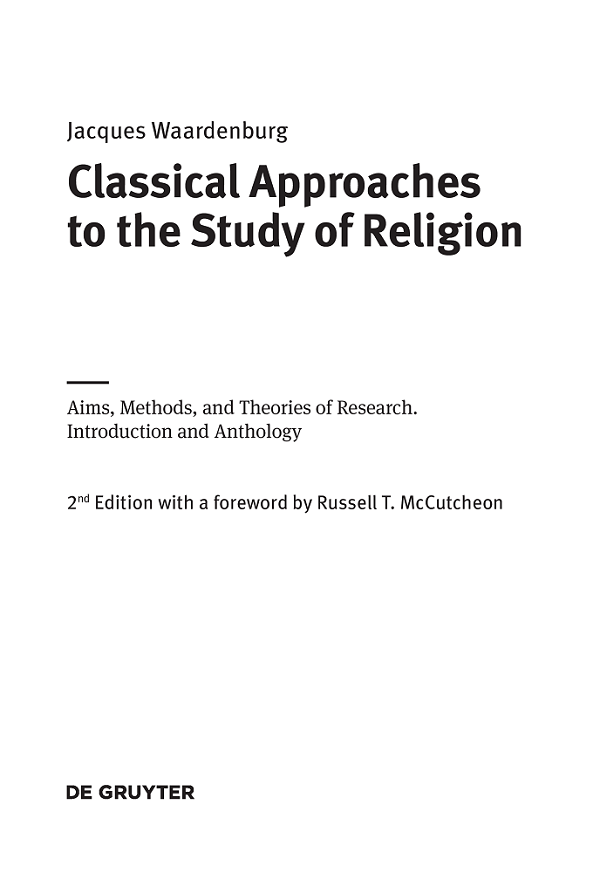
ISBN 978-3-11-046952-3
e-ISBN (PDF) 978-3-11-047359-9
e-ISBN (EPUB) 978-3-11-047386-5
Library of Congress Cataloging-in-Publication Data
A CIP catalog record for this book has been applied for at the Library of Congress.
Bibliographic information published by the Deutsche Nationalbibliothek
The Deutsche Nationalbibliothek lists this publication in the Deutsche Nationalbibliografie; detailed bibliographic data are available on the Internet at http://dnb.dnb.de.
2017 Walter de Gruyter GmbH, Berlin/Boston
www.degruyter.com
Foreword: Plus a change
Progress, far from consisting in change,
depends on retentiveness. When change is
absolute there remains no being to improve and
no direction is set for possible improvement:
and when experience is not retained, as among
savages, infancy is perpetual. Those who cannot
remember the past are condemned to repeat it.
George Santayana, The Life of Reason
(Chpt. 12; 1905)
I am honored to set the stage for a reprinted edition of Jacques Waardenburgs (1930 2015) important anthology, Classical Approaches to the Study of Religion: Aims, Methods and Theories of Research ; in doing so, I hope to make plain why the text remains relevant and why, despite some contemporary readers possibly not being aware of the book, they should have this volume on their shelves. And, in doing so, I also hope that it becomes clear why I opted to open with an epigraph from a different, more than one-hundred-year-old book, using a quotation arising from a chapter significantly entitled Flux and Constancy in Human Nature. Though this quote contains a frequently cited and thus more than likely familiar sentence that may strike readers as a sensible way to think about the utility of reprinting Waardenburgs collection of historical readings, the mostly unquoted and therefore unfamiliar context that precedes this well-known line about remembering the past may prove even more interesting to us, inasmuch as the less familiar wording probably strikes contemporary readers as, well, just a little too strangesuch as the casually cited distinction, typical of that era, between presumably advanced and civilized peoples, on the one hand, and, on the other, the so-called savages who were thought by many of our nineteenth-century, social evolutionary predecessors to represent the childhood of the species, as they might have phrased it. whenever we refer to itand, inevitably, there are consequences to the choices we make. So, since we have no option but to chooseand if, as scholars, we wish to be purposeful in making our selectionswe would be wise not just to be familiar with the selections made by others but also the prices their preferences required them to pay. Thus, despite many readers hardly subscribing to a social Darwinist approach today (although it is worth adding that such an approach is hardly absent from modern scholarshipthink, for a moment, of how popular the attendant notion of the so-called Axial age still is among otherwise respected scholars), there may be something to be gained (whether we join those late nineteenth-century optimists and call it progress or not) by being well acquainted with earlier versions of the assumptions and tools we commonly employ today.
For those who are not specialists in the history of the study of religion itself, but who, instead, work in any one of its many sub-fields (e.g., East Asian religions, myth and ritual studies, Christian origins, religion in America, Paganism studies, religion and film, religion and food, religion and pop culture, and so on), there may be no better way to consider the intellectual context of what we do today than by revisiting Waardenburgs nearly eighty-page introductory essay and the almost seven hundred pages of primary source readings he selected. ligion or the International Association for the History of Religions conferences or, instead, go to conferences with anthropologists or classicists? After all, were each trained as specialists, with little in common with members of other specialties Oh, I dont do the epistles, a New Testament scholar I knew once saidand so, apart from sheer happenstance, many of us likely have no articulate reason for why our offices are next door to whomevers, or why particular students take classes with one another. After all, a common course for all new graduate students, possibly devoted to broad themes in or even the history of the field, is often seen as an ordeal to just get through, so that, once this rite of passage is behind them, each can get on with the specialty they came to grad school to study.
This problem of self-definition and disciplinary identity has been an enduring topic, of courseone that is no less apparent today than in all those earlier essays on such topics as retrospect and prospect in the study of religion. So, Waardenburgs efforts in the early 1970s to argue for the coherence of an interdisciplinary study of religion and then to provide a canon of ancestors (many of whom are usually cited as founders of yet other modern disciplines) and excerpted readings, thereby suggesting a genealogy of the modern field, are no less relevant today than when the book first appeared. For despite early and widespread efforts (of which Waardenburgs were just a part) to strictly distinguish what some once called the science of religion, comparative religion, Religionswissenschaft , the history of religions, or (as most commonly known to some) religious studies from elite participant reflections on the origins, meaning, and purpose of the faith (what was usually called theology), the manner in which many today find it unproblematic to assume that both discourses complement and thereby enhance one anothernot to mention the continued presumption that what we study are merely the public projects of an invisible, inner, and strictly private sentiment expressed in virtually any and every human action (as Ive noted in the past, the religion and taxonomy is virtually endless)indicates that issues of definition, delimitation, and institutional identity are no less relevant today.
Yet for some, it may be tough to be persuaded of the continued relevance of the volume in your hands, for they may have difficulty getting past the fact that it was originally published over forty years ago (by Mouton of The Hague). At the time, this book appeared as the first of a two-volume set, published as volumes three and four, respectively, in the still-noted Religion and Reason series (which now numbers almost sixty volumes)a series that Waardenburg himself founded in 1971. In fact, the series original thirteen-person editorial board, which included Robert Bellah, Ugo Bianchi, Mircea Eliade, Clifford Geertz, Ninan Smart, and Geo Widengren, was a virtual whos who of the study of religion at the time. The book therefore may strike some today as itself being a relic from the past, despite it being re-issued by Walter de Gruyter, in softcover and with a new prefIn many ways, then, our world has changed much since 1973, for several generations of students and scholars have been trained, and some have even completed the entirety of their careers during that time; Id wager that, at least for the more recent of those students and even scholars, Waardenburgs efforts to keep our attention on our intellectual past, as a way to shape our present and future, are largely unknown. With myself in mind I can say that had my own interests not steered toward the history of the study of religion, and had I not worked with Donald Wiebe in my doctoral studies (someone who has himself published in this same series and is well-known for his own interest in the early years of the field), its reasonable to think that I too would not have known about the book or even the author, would not have met him at conferences, and would surely not have grabbed that copy of the first (provocatively orange) hardback edition that I found on the shelves of a used bookstore in Toronto back in the late 1980s. So I understand that, for some, overlooking the obvious distance between ourselves, our interests, our questions, and this forty-year-old volume may present a challenge.

